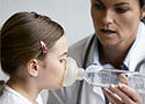Healthcare Professionals
Centers for Disease Control and Prevention
Particle Pollution and Your Patients’ Health
Evidence-based and Accredited Training for Healthcare Professionals on particle pollution exposure, biological mechanisms responsible for associated health effects, and use of the EPA Air Quality Index to protect health.

Allergy Testing for Persons with Asthma[PDF – 96 KB](https://www.cdc.gov/asthma/asthma_inhalant_allergens_webinar.pptx)
This fact sheet discusses how allergies affect individuals with asthma and allergy testing.
Asthma: A Presentation of Asthma Management and Prevention (Slide Presentation and Speaker Notes)(https://www.cdc.gov/asthma/speakit/default.htm)
This 75-slide presentation depicts the pathophysiology of asthma; prevalence, mortality, and morbidity measures at the national level; risk factors; medical management; and the public health response needed to successfully fight asthma.
Quality Measures Summary[PDF – 613 KB](https://www.cdc.gov/asthma/pdfs/quality_measures_summary_3_18_15.pdf)
Quality measures are tools that help measure or quantify healthcare processes, outcomes, patient perceptions, organizational structure, and systems and are associated with the ability to provide high-quality health care.
H1N1 and Seasonal Influenza
People with asthma are at high risk of developing complications after contracting the influenza virus, yet most people with asthma do not receive an annual flu vaccination. Children and adults with asthma should receive influenza vaccinations.
-
Patients with Asthma: Considerations for Clinicians Regarding 2009 H1N1 Influenza Virus(https://www.cdc.gov/h1n1flu/asthma_clinicians.htm)
Persons with asthma are at higher risk for influenza-related complications, such as pneumonia.
H1N1 Influenza
2009 H1N1 Flu (Swine Flu)(https://www.cdc.gov/h1n1flu)
Find out more about novel H1N1 and CDC’s public health response.
-
H1N1 Flu Clinical and Public Health Guidance(https://www.cdc.gov/h1n1flu/guidance)
Current guidance to help health care providers, public health officials and the public address the challenges posed by this public health threat.
-
Novel H1N1 Influenza: Resources for Clinicians(https://www.cdc.gov/h1n1flu/clinicians)
This page is designed to give clinicians access to the latest guidelines and information on the evolving novel H1N1 influenza investigation.
-
H1N1 Flu Vaccination Resources(https://www.cdc.gov/h1n1flu/vaccination)
A vaccine to protect against novel H1N1 influenza is expected to be available this fall. CDC’s Advisory Committee on Immunization Practices(https://www.cdc.gov/h1n1flu/vaccination/acip.htm) has made recommendations for a voluntary novel H1N1 vaccination effort to counter a possibly severe upcoming flu season. Various clinical trials have begun, some under the direction of the National Institutes of Health and others by manufacturers under contract with Health and Human Services.
-
Novel H1N1 Vaccination Recommendations(https://www.cdc.gov/h1n1flu/vaccination/acip.htm)
Provides updated interim guidance on the use of antiviral agents for treatment and chemoprophylaxis of novel influenza (H1N1) virus infection, and assist clinicians in prioritizing use of antivirals for treatment or chemoprophylaxis of patients at higher risk for influenza-related complications.
-
Seasonal Influenza
-
Asthma and Flu Shots(https://www.cdc.gov/asthma/flushot.htm)
-
Flu Symptoms and Severity—Anyone Can Get the Flu, But the Disease Is More Severe for Some People(https://www.cdc.gov/flu/about/disease/symptoms.htm)
-
Persons for Whom Annual Vaccination Is Recommended(https://www.cdc.gov/flu/professionals/acip/persons.htm)
Agency for Toxic Substances and Disease Registry
Case Studies in Environmental Medicine: Environmental Triggers of Asthma
This document is designed to increase the primary care provider’s knowledge of hazardous substances in the environment and to promote the adoption of medical practices that help evaluate and care for potentially exposed patients.
Medical Organizations—Respiratory Diseases
American Academy of Pediatrics
This site offers information to help you learn more about childhood asthma and allergies.
- American Academy of Pediatrics PediaLink Asthma Curriculum
- State of Childhood Asthma and Future Directions: Strategies for Implementing Best Practices. Pediatrics 2009;123;S129–214. Available at http://pediatrics.aappublications.org/content/vol123/Supplement_3/.
Accessed: July 1, 2009.
American College of Chest Physicians
This site provides information about prevention and treatment of diseases, including asthma, through education, research, and communication.
American Thoracic Society
The American Thoracic Society fosters the gathering, evaluating, and disseminating of scientific and clinical information. This Web page provides clinical information about asthma.
National Jewish Health
This medical and research center focuses on respiratory, immunologic, allergic, and infectious diseases.

National Asthma Education and Prevention Program: Expert Panel Report 3: Guidelines for the Diagnosis and Management of Asthma (July 2007 update)
The guidelines emphasize the importance of asthma control and introduce new approaches for monitoring asthma. Updated recommendations for managing asthma include an expanded section on childhood asthma (with an additional age group), new guidance on medications, new recommendations on patient education in settings beyond the physician’s office, and new advice for controlling environmental factors that can cause asthma symptoms.
The guidelines were developed by an expert panel commissioned by the National Asthma Education and Prevention Program Coordinating Committee, which is coordinated by the National Heart, Lung, and Blood Institute (NHLBI) of the National Institutes of Health.

NHLBI Guidelines Asthma Care Quick Reference Guide – Revised in 2012 [PDF – 859 KB]
The goal of this guide is to help clinicians provide quality care to people who have asthma. Quality asthma care involves not only initial diagnosis and treatment to achieve asthma control, but also long-term regular follow-up care to maintain control.
Achieving and maintaining asthma control requires providing appropriate medication, addressing environmental factors that cause worsening symptoms, helping patients learn self-management skills, and monitoring over the long term to assess control and adjust therapy accordingly.
Other resources:
- NHLBI’s Healthy People 2010 Respiratory Gateway
This site provides you quick, easy access to information and resources on asthma. - National Asthma Education and Prevention Program
This site provides you information about the program and about asthma according to target audience. - Physician Asthma Care Education
The Physician Asthma Care Education (PACE) program is a multimedia educational seminar to improve physician awareness, ability, and use of communication and therapeutic techniques for reducing the effects of asthma on children and their families. It also provides instruction on how to document, code, and improve asthma counseling reimbursement.
Training Tool for Health Professionals
Asthma and Inhalant Allergens [PPT – 4 MB]
This slide presentation describes the process through which inhalant allergens can affect individuals with asthma; describes the types of inhalant allergens that can affect individuals with asthma; reviews NAEPP recommendations for the evaluation of inhalant allergens for persons with asthma, and reviews NAEPP recommendations for the environmental control of inhalant allergens for individuals with asthma found to be sensitive to inhalant allergens.
Guidelines for the Diagnosis & Management of Asthma: Parts 1 through 4
These comprehensive reading activities present aspects of the National Heart, Lung, and Blood Institute’s Expert Panel Report 3 (EPR3): Guidelines for the Diagnosis and Management of Asthma for practitioners. These activities are free but require registration.
Videos
Know How to Use Your Asthma Inhaler
CDC’s National Asthma Control Program developed this set of videos to help public health professionals explain proper inhaler techniques to people with asthma and to their families and caregivers. These step-by-step instructions are presented in English and in Spanish. Use the videos at your office and provide the website address so that more people are able to control their asthma.
The 15-Minute Asthma Visit
Dr. David Callahan outlines how clinicians can provide evidence-based care for patients with asthma in a 15-minute office visit.
Asthma Control During Travel
Dr. David Callahan outlines how clinicians can prepare patients with asthma for symptom-free travel.
Other
Center of Excellence for Medical Multimedia (CEMM)
The Center of Excellence for Medical Multimedia (CEMM) was established in 1996 with the support and direction of the Office of the Air Force Surgeon General. The CEMM Asthma Web Site provides an overview of asthma. Topics include diagnosis, treatment, prevention, and common triggers of asthma.
Environmental Management of Pediatric Asthma: Guidelines for Health Care Providers
National Environmental Education Foundation’s “Environmental Management of Asthma: Guidelines for Health Care Providers”
- Page last reviewed: August 29, 2017
- Page last updated: August 29, 2017
- Content source:


 ShareCompartir
ShareCompartir